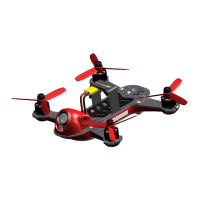Video Transmitter
The Vortex 150 Mini flight controller/OSD board contains an embedded ‘Tramp’ 5.8GHz Video Transmitter.
The frequency, and power level of this transmitter may be programmed using several techniques (several of which
are unique to this product), including:
1) OSD Menu selection (while powered up)
2) TNR Wand (even when powered down)
3) PitStick set after power-up using the R/C remote.
4) DSMX control from a supported Spektrum R/C Transmitter
OSD Menu
The OSD Menu is the ‘traditional’ Vortex method of configuring the video transmitter. The quad is powered up,
transmits on it’s last configured channel, and by entering the OSD menu, the channel may be changed.
TNR Wand
The TNR Wand method is new for the Vortex 150, and allows the video transmitter to be configured before
powering up the quad. This enables the wonderful feature of arriving at a park or race, asking your flying buddies
what channels they are using, and picking a clear channel before powering up.
The TNR feature also supports the Race Director’s wand ‘Race Lock’ and pit mode, where quads may be integrated
into race events in the same way as the Tramp HV.
NOTE: The TNR Wand feature of the 150 requires a wand either from the second production batch (v1.1), or a modified
wand from the first batch (v1.0).
PitStick Mode
The new PitStick mode, unique to the Vortex 150 Mini, is enabled using the Video Tx menu, selecting the required
band (typically RaceBand), and then selecting ‘PitStick’ as the channel number.
When in this mode, the quad will not transmit at all when powered up, but will instead play a tune occasionally
after power-up to remind the pilot that PitStick is active.
For Mode 2 users, use the right stick to select the channel number, as shown below (channel 1 is straight up, each
45 degree step around the clock is another channel number).
No wand required, No OSD settings each time you arrive at the field, just power up, and set the channel using the
R/C Controller.

